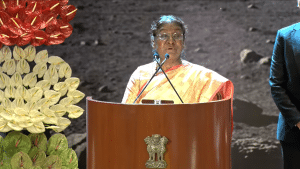The recently released first images from NASA’s James Webb Space Telescope (JWST) have revealed new views of the cosmos in exquisite, never-before-seen detail. Webb’s image covers a patch of sky approximately the size of a grain of sand held at arm’s length by someone on the ground – and reveals thousands of galaxies in a tiny sliver of the vast universe.
The image reveals the depths of the universe and is a window through time. The very faintest, smallest blips of light in these photos are images of galaxies as they existed more than 13 billion years ago, near the very beginning of time. The telescope has not only allowed us to glimpse into the past but will also help answer gaping questions from how galaxies evolved to the composition of exoplanet atmospheres.
According to NASA “Webb will solve mysteries in our solar system, look beyond to distant worlds around other stars, and probe the mysterious structures and origins of our universe and our place in it.”
However, while the JWST will enable us to look into the past and enlighten us about the origins of the universe, our future on this planet remains uncertain. With rising global temperatures, the past few decades have observed a marked aggregation in the propensity and intensity of extreme climatic events.
Climate change has emerged as one of the most critical problems of our age, and the solution to this problem requires a lens into the future. The developments and innovations in remote sensing technology have allowed satellites to serve as this lens and prove instrumental in helping solve climate change.
Satellite Data and Climate Change
The role of satellite data in the continuous monitoring and measuring of climate change is identical to the role of the JWST in monitoring the depths of the universe.
In fact, according to the Global Climate Observing System, more than 50% of Essential Climate Variables, which are key indicators of the earth’s changing climate, can only be tracked via satellites.
For instance, the European Space Agency’s (ESA’s) Climate Change Initiative generates reliable and long-term data for 21 Essential Climate Variables. This wide array of satellite data helps identify our vulnerability to climate change by monitoring and predicting extreme climatic events, such as floods, wildfires, droughts, heatwaves and melting of glaciers, among others.
Assessing Climate Indicators
To mitigate and manage the growing threat of extreme climatic events to various aspects of our society and businesses, data-backed climate intelligence is becoming crucial.
As most climate variables can only be monitored by space, satellites provide a wealth of valuable information to understand the drivers and impact of climate change. Currently, there are around 162 satellites in orbit that are continuously monitoring various climate variables. Some of the climate variables that can be continuously monitored by satellites are as follows:
Wildfires
There has been a sharp rise in the occurrence and intensity of wildfires in recent years. As wildfires are closely associated with climate change, they tend to reinforce each other. Accordingly, as the climate crisis worsens, monitoring fires could play a huge role in minimizing risks.
Satellites in this regard have emerged as an effective monitoring tool that make it possible to observe extensive areas in real-time. Data from satellites also provide valuable insights into wildfire behaviour, such as patterns and likely courses. This along with other essential information such as vegetation in the region, weather conditions that instigate fires, etc can help in creating maps of potential fire hotspots and even help in predicting fires.
Owing to their high temporal resolution and capability to detect fires in remote areas, the US National Oceanic and Atmospheric Administration (NOAA) and Moderate Resolution Imaging Spectroradiometer (MODIS) satellites are polar satellites that have played a significant role in detecting fires globally.

GHG emissions
Greenhouse gas (GHG) emissions increase the heat in the atmosphere, which leads to global warming. As long as emissions continue, global temperature will also continue to rise. Thus, monitoring and mapping GHG emissions is crucial in developing strategies to reduce them. Satellite data in this regard plays a prominent role as it has the ability to pinpoint emissions.
In 2009, Japan launched the Greenhouse Gases Observing Satellite (GOSAT), the world’s first satellite to monitor greenhouse gases. Since then, several more sophisticated satellites have been launched for the same purpose. At present, the Copernicus Sentinel-5P, launched in 2018 by the European Space Agency (ESA), is known to be the most advanced pollution monitoring satellite in the world. More recently, in 2021, ESA announced their new space mission, which will be able to track human-caused GHG emissions from space.

Floods
Climate change is causing floods to become increasingly intense and frequent. Accordingly, credible data is of utmost importance as it can help in mapping and managing floods and potentially even accurately predicting them. Owing to its vantage point, satellites provide information on the global occurrence and footprint of floods in near real-time. It also helps in understanding the scale and extent of flooding. For example, researchers used NASA’s TOPEX/Poseidon satellite and ESA’s ENVISAT satellite to calculate the height and extent of flooding in various regions.
Satellite imageries are also helpful in creating predictive models that could help in tentatively forecasting floods. Here, satellites use weather patterns to calculate the tentative amount of rain each area might receive. Spatial images of the ground also enable the calculation of the water retention capacity of the ground.
In addition, NASA’s Tropical Rainfall Measuring Mission (TRMM) satellite provides scientists with insights into the amount of moisture content in the soil. This is a key factor which helps in estimating the chances of the occurrence of floods. These crucial bits of information cumulatively help in developing flood risk maps. This further helps authorities to predict floods and be better prepared to manage them.

Droughts
Climate change is causing droughts to become more frequent and severe. As the impact is far-reaching, ranging from affecting water quality, public health, economy and public infrastructure, among others, monitoring and predicting droughts has become vital in managing the crisis. Satellites can play an important role in predicting droughts. They do this by measuring radiation, which helps in accurately measuring soil moisture levels.
This provides beneficial insights into weather conditions. For example, if satellite measurements find that soil is getting increasingly wet, it may indicate that a flood is imminent.
Likewise, if it finds the moisture content in soil drying up, it could be an indicator of a potential drought. For instance, the Advanced Scatterometer (ASCAT) on board EUMETSAT’s polar-orbiting Metop satellites measure moisture content in the soil, among other things.
Remote sensing also tracks factors such as weather patterns and wind speed which influence weather conditions such as droughts. In addition, satellites also help in assessing the impact of droughts on vegetation. The satellite-based Fraction of Absorbed Photosynthetically Active Radiation (FAPAR) in this regard helps in assessing the impact of droughts.
Additionally, it is essential to monitor various surface water bodies continuously for effective and sustainable water management and preempting droughts. For instance, water levels of lakes going down may indicate the first signs of impending droughts.
Also Read: Building a Geospatial Data Refinery for Climate Intelligence

Deforestation
Deforestation is one of the most pressing challenges we face today, as the world’s tropical rainforests were estimated in 2019 to disappear at the rate of one football pitch every six seconds. Deforestation and land degradation act as a double-edged sword as they not only rob the world of naturally occurring carbon sinks but also result in the release of the stored carbon back into the atmosphere.
The severity of this problem was highlighted in 2021 when scientists alarmingly confirmed for the first time that the Amazon rainforest emitted more carbon dioxide than it was able to absorb (close to 1 billion tonnes) primarily due to deforestation, fires, degradation, etc. As the crisis worsens, monitoring deforestation has become extremely vital.
With traditional methods such as forest guards having been found to be expensive and time-consuming, satellite data has revolutionized the monitoring of deforestation with high-resolution data.
Satellites in this regard present imageries of earth on a daily basis which help in mapping deforested areas over a period of time and in identifying hotspots.
In fact, a new study has found that satellites are helping in reducing deforestation. Earth-orbiting satellites were found helpful in bringing down deforestation by 18% over two years in 22 African countries.
The countries took the help of systems that used up-to-date satellite data to send out alerts regarding decreases in forest cover in the tropics. Similarly, the Brazilian government established a data-collection system called PRODES, which uses high-resolution data from Landsat 5 and 7 satellites to monitor and map deforestation.

What does the future hold?
Satellite data has inevitably emerged at the forefront of climate action and the climate intelligence landscape. It not only addresses the shortcomings of traditional monitoring tools such as IoT monitors, forest guards, etc., but rapid technological expansion has also enabled it to provide unique and precise solutions to various challenges.
For example, a major limitation of optical satellites was the lack of clarity due to obscurement by clouds and darkness in mountainous regions. New radars developed can surpass these limitations. New generation satellites also have enhanced optical and temporal resolutions that have improved climate modelling and have capabilities to obtain real-time details.
The expansion of technology and innovation in the field thus holds tremendous promise. New satellite missions such as Eumetsat’s second-generation polar-orbiting satellites and third-generation Meteosats are expected to have immense value in the coming years.
With several path-breaking space 2.0 systems due to be launched in the coming years, clubbed with innovations in artificial intelligence and IoT, the scope of space-based technologies in transitioning into a more sustainable future is immense.
While geospatial data has emerged as a near-perfect solution to monitoring indicators of climate change, acquiring insights from its raw form is impossible. Before satellite data can be applied to climate mitigation, it needs to be processed.
This is true for any big data and today, less than 1% of global data is analysed. However, this process of extracting relevant insights from terabytes of satellite data comes at a high cost in both expertise and computing infrastructure; a key reason this information is under-utilized for understanding environmental challenges.
Hence, organizations with strong analytical skills and computational capacity will play an important role in this regard in integrating valuable data from various sources and disseminating insights through APIs.
Innovation in this sector would be key to unlocking the true potential of satellite data and successfully solving the climate crisis. After all, the images from the JWST also, are only as good as our understanding of them.
Also Read: Five years of forest fires cost more than the net worth of Microsoft








